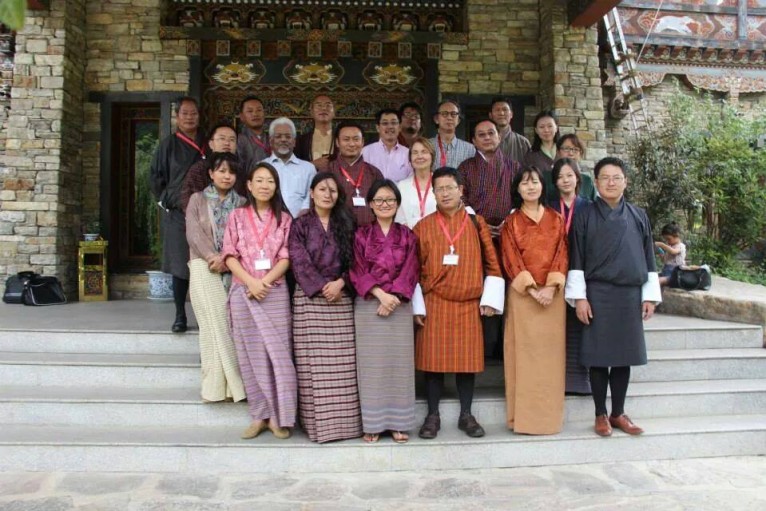A farmer’s experiment using stuffed toy tigers to frighten away menacing monkeys may prove to be the inspiration that will spark a reinvention of journalism in Bhutan, the remote Himalayan kingdom known for its daring goal to achieve Gross National Happiness (GNH).
That’s the hope that sums up my recent trip to Bhutan, where I worked with some of the country’s leading newspaper, television and radio journalists as they struggle in the jaws of the rapid political, economic and technological changes sweeping the tiny Himalayan nation. The anecdote about the stuffed tigers, which help protect the farmers’ crops, came to symbolize the creative problem-solving needed to confront these challenges.
This was my second trip to Bhutan at the invitation of the Bhutan Centre for Media and Democracy (BCMD), which has been convening the journalists. Following my first visit in 2013, I described how the nation’s much-beloved king decided it was time for Bhutan to become a democracy, setting the stage for a new constitution and an elected parliament. It was also the king who created the GNH agenda, which attempts to balance economic development with a respect for the country’s pristine environment and rich culture and the fostering of good governing practices.
I also confessed puppy love—and deep respect—for the journalists, who are passionate about journalism and their culture. But the journalists also are beleaguered. Their most urgent challenge is the need to find ways to ensure the sustainability and independence of the news media. Right now, the government partly owns the nation’s largest newspaper and television-radio network. Plus, most newspapers have relied so far on the government for 80 percent of their advertising, and they know this won’t last. Some newspapers have folded already.
The journalists also are concerned that the rough-and-tumble nature of politics is disrupting the traditionally harmonious nature of this Buddhist-dominated society. The rancorous 2013 elections—only the nation’s second in history—split the country and some families. Reporters often found themselves accused of colluding with one political party or another. An American accustomed to our caustic campaigns might have trouble understanding how jarring the change has been for Bhutan’s citizens, many of whom take time daily to visit a temple or prayer site.
“The game of politics only seems to divide us further,” one discouraged reporter said. (To promote more open dialogue, we agreed that the discussions would be kept confidential.)
BCMD invited Judy Rodgers, founding director of Images and Voices of Hope (IVOH), and I to facilitate the dialogue. (I serve on the board of IVOH, a U.S.-based nonprofit whose mission is to strengthen the role of media as agents of world benefit.) In our last conference, Judy and I asked the participants to clarify their personal values and goals as journalists.
This time we asked them to think concretely about what Bhutan needs from its journalists at this pivotal time in history. It was clear that they would like to thread a path that avoids some of the extreme forms of journalism that they see in other countries. A prominent reporter/editor from Thailand invited to offer outside perspectives warned the Bhutanese not to follow his country’s lead, which he described as “mad dog journalism” because it often veers towards sensationalism and inaccuracy. Similarly, he urged them to rise above the “lap dog” model in Singapore, where many journalists are so cozy with the government that they are afraid to upset the “golden bird nest.”
Likewise, a prominent Indian journalist warned how the newsroom’s integrity can be weakened when big, profit-driven corporations take over newspapers and television stations. I talked about how the implosion of the business model for news has forced journalists and news outlets in the U.S. to buckle down and reinvent themselves, sparking waves of experimentation—new kinds of revenue schemes, nonprofit news groups, storytelling methods, uses of technology and social media, etc. As examples, I described IVOH’s restorative narrative initiative, which promotes stories that help communities recover from disasters and crises, and Renaissance Journalism’s Michigan Reporting Project, in which nine news organizations are collaborating to cover that state’s financial problems.
To stimulate experimentation, Siok Sian Pek-Dorji, BCMD’s founding director, announced the start of a new fellowship program. Her organization will offer grants to journalists and news outlets for the most innovative proposals to cover rural community issues. Even though 80 percent of Bhutan’s residents live in rural villages, they receive scant coverage by newspapers and television and radio stations, which are based in the cities. The journalists themselves brought up this problem many times during our 2013 conference.
This is how the anecdote about the stuffed tigers, which had come up during the first day of the conference, became more relevant. The journalists split into small groups to brainstorm mock applications for the BCMD fellowship. One group came up with a project to look for examples in which people in rural communities came together after the elections to heal their political wounds. They called it “Reunite Bhutan.” A second group took the stuffed tigers idea and created a project to examine how rural villagers demonstrate their own creativity and resilience when they dream up solutions for common problems.
Both groups said they hoped that their stories would inspire other residents and offer new perspectives about rural communities. While news collaborations are rare, both groups proposed that television, radio, newspapers and others work together. As the conference drew to a close, the journalists were making plans to submit proposals to BCMD, which delighted Pek-Dorji. One of her goals was to help coalesce a “fraternity of journalists” willing and able to come together to solve the common challenges to their profession. Stuffed tigers may become the symbol for this effort. Will it work? Stay tuned.


